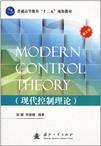现代控制理论
2012-3
国防工业出版社
胡健,刘丽娜 编著
186
本书内容共分为6章,主要涉及系统建模、系统分析和系统优化设计。第l章通过引入控制系统的一些基本概念,给出了系统的数学描述方式,如:状态空间模型,传递函数矩阵。第2章在时域内对系统进行了定量分析。第3章和第章主要进行了系统的定性分析。其中,第3章讨论了系统的稳定性问题,第4讨论了系统的能控性和能现性问题。第5章研究了系统综合设计的方法,例如:状反馈,利用状态观测器进行状态重构。在第6章中,研究了离散系统的建模、分析综合设计。
本书可作为自动化、电气工程厦其自动化等专业高年级本科生以厦控制科学与工程、电气工程等学科研究生学习现代控制理论双语课程的教材也可作为学习高级宏、微观经济学的经济、管理学科研究生的辅助教材。
Chapterl State Space Description
1.1 Definition of State Space
1.1.1 Exmple
1.1.3 State Space Description
1.1.4 Transfer Function Matrix
1.2 Obtaining State Space Description from I/O
Description
1.2.1 Obtaining State Space Description from Differential
Equation
1.2.2 Obtaining State Space Description from Transfer
Function
1.2.3 Obtaining State Space Description from Block Diagram
1.3 Obtaining Transfer Function Matrix from'State Space
Description
1.4 Description of Composite Systems
1.4.1 Basic Connection of Composite Systems
1.4.2 Description of the Series Composite Systems
l.4.3 Description of the Parallel Composite Systems
1.4.4 Description of the Feedback Composite Systems
1.5.1 Eigenvalue and Eigenvector
1.5.2 State Transformation
1.5.3 Invariance Properties of the Stare Transformation
1.5.4 Obtaining the Diagonal Canonical Formby State
Transformation
1.5.5 Obtaining the Jordan Canonical Form by State
Ttansformation Problems
Chapter2 Time Response of the LTI System
2.1 Time Response of the LTI Homogeneous System
2.2 State Transition Matrix
2.2.2 Properties oi the State Transition Matrix
2.3 Calculation of the Matrix Exponential Function
2.3.1 Direct Method
2.3.2 Laplace Transform Method
2.3.3 SimdariTy TransfoRation Method
2.3.4 Cayley Hamihon Theorem Method
2.4 Time Response of the LTI System
Chapter3 Stability of the control System
3.1 The Basics of Stability Theory in Mathematics
3.2 Lyapunov Stability
3.2.1 Equilibrium Point
3.2.2 Cocepts of Lyapunov Stability
3.3 Lyapunov Stability Theory
3.3. ] Fyapunov First Method
3.4 Application of Lyapunov 2 Method to the LTI
System
3.5 Construction of Lyapunov Function to the Nonlinear
System
Chapter4 Controllability and Observability
4.1 Controllability of The LTI System
4.1.1 Cntrollability
4.1.2 Criteria of ControlIabillty
4.2 Observability of The LTI System
4.2.1 Observahility
4.2.2 Criteria of ()bservability
4.3 Duality
4.4 Obtaining the Controllable and Observable Canonical Form
by State Transformation
4.4.1 Obtaining the Controllable Canonical Form by State
Trahsformation
4.4.2 Obtaining the Obserable Canonical Form by State
Trarlsformation
……
Chapter5 Synthesis of the System
Chapter6 Discrete Time Control System
Index
References
Example 1.1 A very simple RLC network shown in Figure 1.1 is considered. Suppose that the voltage u(t) is the input to the RLC network. This circuit contains two energy-storage elements: the inductor and the capacitor. Applying Kirchhoff's laws, the voltage uc (t) across the capacitor C and the current iL (t) through the inductor L satisfv the following diifferential equations. The second-order differential equation (1. 4) is called the differential equation description of the system.The differential equation description can be directly converted to the transfer function description by Laplace transform. By taking the Laplace transform of (1.4) and assuming the zero initial conditions hold true, the transfer function description of the RLC network is obtained asFrom the description (1.4) and (1.5), it can be seen that the differential equation description and the transfer function description are all the external descriptions of a system. If we make the definitions,x1(t) = uc(t) and X2 (t) =iL (t), for t∈(0,t], the following differential equations can be obtained from (1.1) and (1.2). The set of the differential equations in matrix form (1.8) or(1.9)is called the state equation of the system. The set of the algebraic equations in the matrix form (1.11) is called the output equation of the system. Both the state equation and the output equation are called the state space description of asystem. The state space description is an internal description of system. Lyapunov asymptotically stability means that we are able to select a bound on initial condition, that will result in the state trajectory which remains within a chosen finite limit and will return to Xe. The geometrical implication of Lyapunov asymptotically stability is shown in Figure 3. 2. Definition 3.9 If δ, which is appear in (3.19) and indicates the bound on initial condition, is not the function of to and the equilibrium point Xe is stable i. s. L, then Xe is said to be uniformly stable. Definition 3.10 If δ, which is appear in (3.19) and indicates the bound on initial condition, is not the function of to and the equilibrium point Xe iS asymptotically stable i. s. L, then Xe iS said to be ruuformly asymptotically stable. Definition 3.11 If the equilibrium point Xe iS asymptotically stable i. s. L for any initial state, then the equilibrium point Xe iS said to be globally asymptotically stable or asymptotically stable in the large. ……
《普通高等教育十二五规划教材:现代控制理论(英文版)》可作为自动化、电气工程及其自动化等专业高年级本科生以及控制科学与工程、电气工程等学科研究生学习现代控制理论双语课程的教材,也可作为学习高级宏、微观经济学的经济、管理学科研究生的辅助教材。
